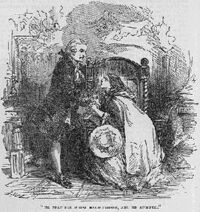UnBook: A Tale Of Two Cities
It was the best of books, it was the worst of books,
it was taught at the age of middle school, it was taught at the age of college,
it was the epoch of boredom, it was the epoch of enlightenment,
it was the season of long, flowery prose, it was the season of seemingly endless exposition,
it was the spring of enjoyment, it was the winter of hatred,
it was everything before us, it was nothing before us,
we were all enjoying this book, we were all the other way--
In short, A Tale of Two Cities has elicited a wide range of reactions so far as the present time.
Kids wrote papers on it to submit for a grade, kids bought papers about it to submit for a grade. It made people reading fall asleep, it made people reading not fall asleep. It created a world of discontent, it failed to engage its reader into the world of Revolutionary Europe. People read it during the day, they read it during the night. They read it for a class, they read it for pleasure. Readers found the action exciting, readers found it boring. It was often parodied, it was often taken seriously.
The sky was blue when it read was it, the sky was dark. They read it in mid-afternoon, they read it late at night. They read the whole thing, they didn't read it at all. There were illustrations in it, there weren't illustrations in it. They read the adult version, they learned the basic and simplified story from Wishbone. They consider it the best Charles Dickens book ever made, they think this book is trash.
Before we tell you the plot of A Tale of Two Cities, you must first learn the story behind it.
Part One; in which Charles Dickens meets his lovely[edit]
Chapter One; in which Mr. Dickens saves his lovely's fiance[edit]
Fiften years before the book was written, Charles Dickens was a small-time merchant who was in the business of smuggling the French across the English Channel from revolutionary France. It was while he was smuggling these Frenchmen that he discovered the most lovely lady he had ever seen in his life. It was there, amongst the stony white cliffs of Dover that he decided he would make this woman his mistress.
Alas, it was not to last. This woman, unfortunatly, was the fiance of the Lord Norris of Essex, who was still trapped in the Bastille in Paris for crimes against Marie Antoinette. For love, Dickens decides to sneak into Paris to save his lovely's fiance.
After single handedly convincing the French peasantry to storm the Bastille, Dickens climbed the cold, stony, uneven stairs to the top tower room. There, on a rickety bed, eyes looking towards God, sat Lord Norris of Essex, awaiting his fate at the hands of the Royal Throne.
"Oh dear!" said Dickens. "Imagine that we meet!"
He, of course, was referring to the irony that Dickens would save such a man, who currently had the heart of Charles' beloved beneath his boots. Charles had met this man's fiance while smuggling the French aristocracy across the English Channel, as they could escape revolutionary France. Charles instantly fell in love with this woman, whose fiance was trapped in the Bastille for crimes against Marie Antoinette.
"By what do you mean of that?" Lord Norris asked.
Charles ignored Lord Norris and was lost in thought about his lovely--her beautiful white dress, her gorgeous brown eyes, her corset-shaped bosom. Although he was trapped in this jail cell, it seemed gloriously light while he thought of her.
"Come, we must go," stated Mr. Dickens, and the two ran down the stairs and out onto the street.
Chapter Two; in which Lord Norris and his fiance are reunited[edit]
The two men entered the boat of Mr. Dickens at the port city of Calais. Calais is to the northwest of Paris by some miles, with many a Revolutionary Soldier along the single, muddy road. The two had hidden their identities as hags, but Madame Tuer, a peasant woman of large girth and anger, recognized them as they left as Lord Norris and Mr. Dickens. The madame kept it in the back of her mind for later, for she felt an unexplainable hatred for those two men.
"How do you know my fiance?" Lord Norris asked Mr. Dickens.
"Oh, I helped her across the Channel," Charles replied, failing to leave out that he had loved her from the moment he set eyes on her.
"Ah!" Lord Norris said, looking down at the rowing street urchins below them. He threw a haypenny down the wet, wooden deck; the dust covered orphans scrambled around the coin--it was the most money they had ever seen in their lives. "Do you suppose the street urchins have souls, Mr. Dickens?"
"Oh, heavens no!" Charles began. "But suppose they did. That would make a great story."
After giving the malnourished orphans food to continue their voyage, the two met the future Lady Norris. She once again was wearing all white, her hair drenched by the perspiration of one thousand tears of worry. Charles' heart beat twice; he felt the love of his beloved heading in his general direction.
The Second Part[edit]
Where Charles Dickens gave up his quest and returned to his first love.

